2012 Peugeot 508 roof
[x] Cancel search: roofPage 4 of 340

.
Contents
Instrument panel 22
Indicator and warning lamps 23
Gauges and indicators 33
Tr ip computer 38
Instruments and controlsFamiliarisation
Remote control key 41
Alarm 50
Electric windows 52
Boot 54
Motorised tailgate (SW) 55
Sunroof 58
Panoramic sunroof (SW) 60
Fuel tank 61
Diesel misfuel prevention 62
Access
Front seats 64
Rear seats 69
Mirrors 71
Steering wheel adjustment 73
Interior fi ttings 74
Boot fi ttin
gs (Saloon) 77
Boot fi ttings (SW) 78
Heating and Ventilation 83
Manual air conditioning 85
Dual-zone digital air conditioning 87
Quad-zone digital air conditioning 90
Rear screen demist - defrost 95
Programmable Heating/Ventilation 96
Comfort
Starting-switching off the engine 97Electric parking brake 99Manual parking brake 106Manual gearbox 107Gear shift indicator 108Automatic gearbox 1096-speed electronic gear control gearbox 113Stop & Start 117Hill start assist 120Head-up display 121Speed limiter 124Cruise control 126Parking sensors 128Parking space sensors 130
Driving
Lighting controls 132
Automatic illumination of headlamps 137
Headlamp adjustment 140
Directional lighting 141
Wiper controls 143
Automatic rain sensitive wipers 145
Cour tesy lamps 147
Interior mood lighting 148
Visibility
Eco-driving 20
Page 5 of 340
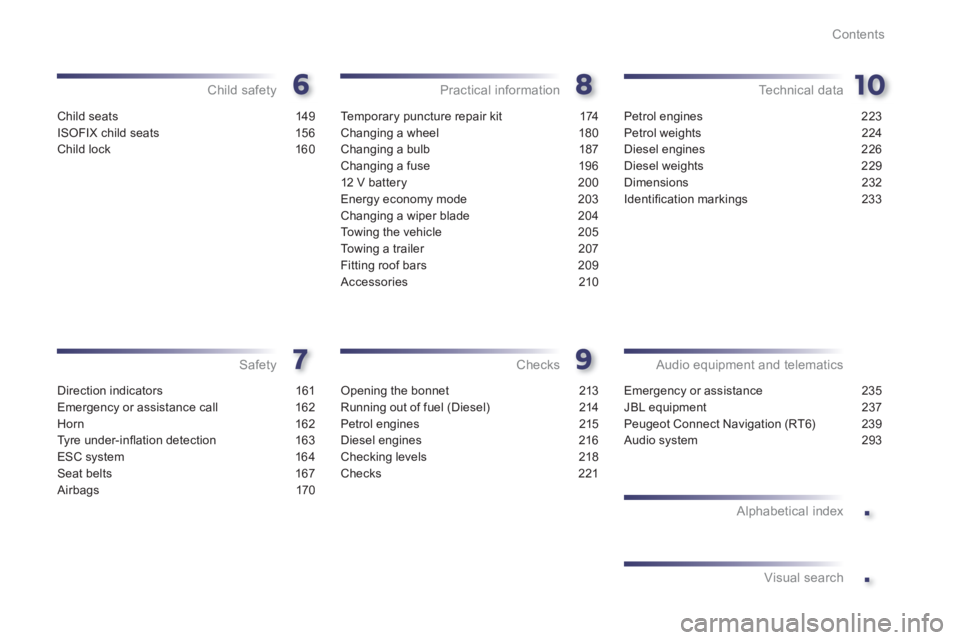
.
.
Contents
Child seats 149
ISOFIX child seats 156
Child lock 160
Child safety
Direction indicators 161
Emergency or assistance call 162
Horn 162
Tyre under-infl ation detection 163
ESC system 164
Seat belts 167
Airbags 170
Safety
Te m p o r a ry puncture repair kit 174
Changing a wheel 180
Changing a bulb 187
Changing a fuse 196
12 V battery 200
Energy economy mode 203
Changing a wiper blade 204
To w i ng the vehicle 205
To w i ng a trailer 207
Fitting roof bars 209
Accessories 210
Practical information
Opening the bonnet 213
Running out of fuel (Diesel) 214
Petrol engines 215
Diesel engines 216
Checking levels 218
Checks 221
Checks
Petrol engines 223
Petrol weights 224
Diesel en
gines 226
Diesel weights 229
Dimensions 232
Identifi cation markings 233
Technical data
Emergency or assistance 235
JBL equipment 237
Peugeot Connect Navigation (RT6) 239
Audio system 293
Audio equipment and telematics
Alphabetical index
Visual search
Page 22 of 340
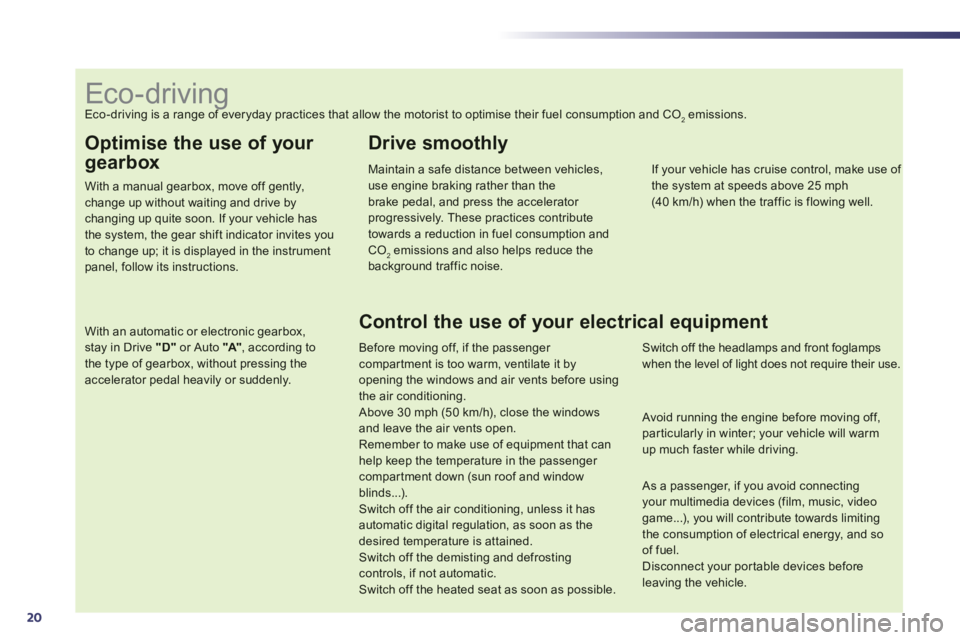
20
Optimise the use of your
gearbox
With a manual gearbox, move off gently,change up without waiting and drive by changing up quite soon. If your vehicle has the system, the gear shift indicator invites youto change up; it is displayed in the instrumentpanel, follow its instructions.
With an automatic or electronic gearbox, stay in Drive "D"or Auto "A" , according to the type of gearbox, without pressing theaccelerator pedal heavily or suddenly.
Drive smoothly
Maintain a safe distance between vehicles,use engine braking rather than thebrake pedal, and press the accelerator progressively. These practices contributetowards a reduction in fuel consumption andCO2emissions and also helps reduce thebackground traffic noise.
If your vehicle has cruise control, make use of the system at speeds above 25 mph (40 km/h) when the traffic is flowing well.
Control the use of your electrical equipment
Before moving off, if the passenger compartment is too warm, ventilate it byopening the windows and air vents before using the air conditioning.
Above 30 mph (50 km/h), close the windows and leave the air vents open.
Remember to make use of equipment that canhelp keep the temperature in the passenger compartment down (sun roof and windowblinds...).
Switch off the air conditioning, unless it has automatic digital regulation, as soon as thedesired temperature is attained. Switch off the demisting and defrostingcontrols, if not automatic. Switch off the heated seat as soon as possible.
Switch off the headlamps and front foglamps when the level of light does not require their use.
Avoid running the engine before moving off,
particularly in winter; your vehicle will warmup much faster while driving.
As a passenger, if you avoid connecting your multimedia devices (film, music, videogame...), you will contribute towards limitingthe consumption of electrical energy, and soof fuel.
Disconnect your por table devices beforeleaving the vehicle.
Eco-driving Eco-driving is a range of everyday practices that allow the motorist to optimise their fuel consumption and CO2emissions.
Page 23 of 340

.
21
Limit the causes of excess
consumption
Spread loads throughout the vehicle; placethe heaviest items in the bottom of the boot,as close as possible to the rear seats.Limit the loads carried in the vehicle and reduce wind resistance (roof bars, roof rack, bicycle carrier, trailer...). Use a roof box inpreference.Remove roof bars and roof racks after use.
At the end of winter, remove snow tyres and refit your summer tyres.
Observe the recommendations
on maintenance
Check the tyre pressures regularly, when cold, referring to the label in the door aper ture, driver's side.Carry out this check in par ticular:- before a long journey,- at each change of season,- after a long period out of use. Don't forget the spare wheel and the tyres onany trailer or caravan.
Have your vehicle ser viced regularly (engine oil, oil filter, air filter...) and obser ve the schedule of operations recommended by the
manufacturer.
When refuelling, do not continue after the3 rdcut-off of the nozzle to avoid any over flow.
At the wheel of your new vehicle, it is only after the first 1 800 miles (3 000 kilometres) that you will see the fuel consumption settledown to a consistent average.
Page 46 of 340
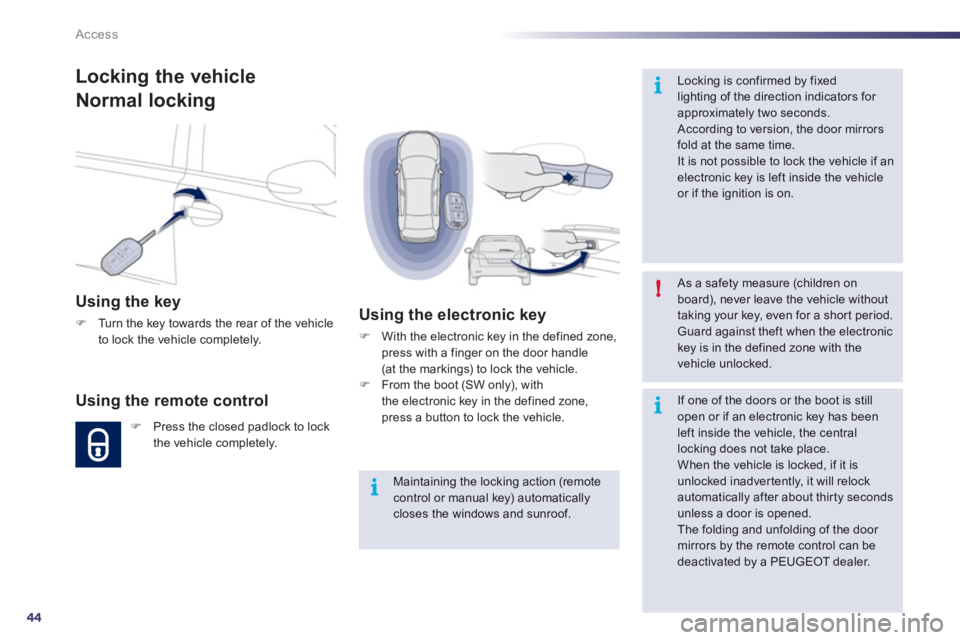
44
i
i
!
i
Access
Locking the vehicle
Normal locking
Using the key
�)Turn the key towards the rear of the vehicle
to lock the vehicle completely.
Using the remote control
�)Press the closed padlock to lock
the vehicle completely.
Using the electronic key
�)
With the electronic key in the defined zone,
press with a finger on the door handle(at the markings) to lock the vehicle.�) From the boot (SW only), with
the electronic key in the defined zone,
press a button to lock the vehicle.
Maintaining the locking action (remotecontrol or manual key) automaticallycloses the windows and sunroof.
As a safety measure (children on board), never leave the vehicle without taking your key, even for a shor t period. Guard against theft when the electronickey is in the defined zone with thevehicle unlocked.
Locking is confirmed by fixedlighting of the direction indicators for approximately two seconds.
According to version, the door mirrors fold at the same time.
It is not possible to lock the vehicle if an electronic key is left inside the vehicleor if the ignition is on.
If one of the doors or the boot is stillopen or if an electronic key has been left inside the vehicle, the centrallocking does not take place.
When the vehicle is locked, if it isunlocked inadvertently, it will relock automatically after about thir ty seconds unless a door is opened.
The folding and unfolding of the door mirrors by the remote control can be deactivated by a PEUGEOT dealer.
Page 60 of 340
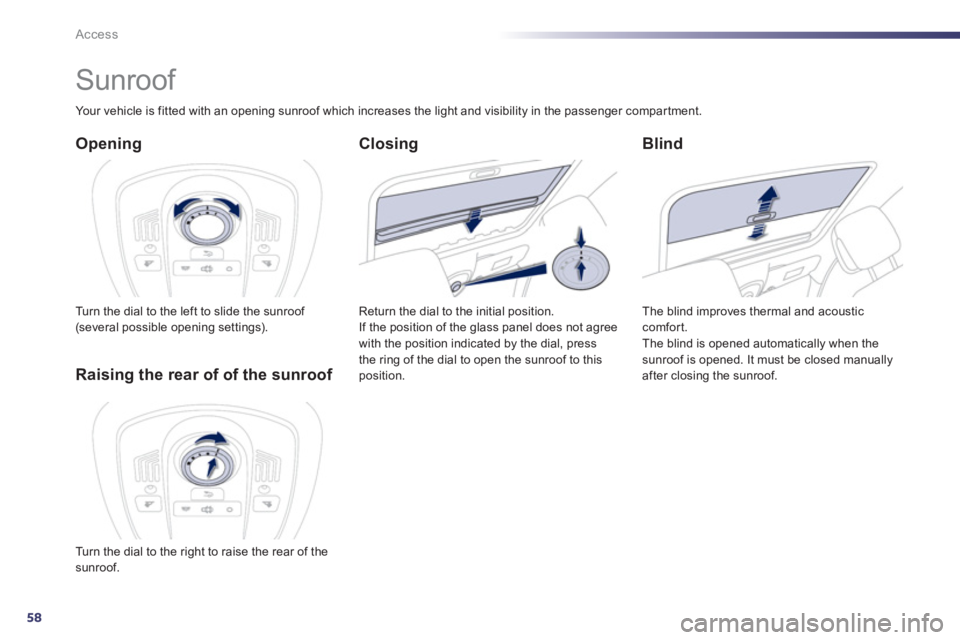
58
Access
Sunroof
Opening
Turn the dial to the left to slide the sunroof (several possible opening settings).
Blind
The blind improves thermal and acoustic comfort.
The blind is opened automatically when the sunroof is opened. It must be closed manually
after closing the sunroof.Raising the rear of of the sunroof
Your vehicle is fitted with an opening sunroof which increases the light and visibility in the passenger compartment.
Return the dial to the initial position.
If the position of the
glass panel does not agree
with the position indicated by the dial, press
the ring of the dial to open the sunroof to thisposition.
Closing
Turn the dial to the right to raise the rear of thesunroof.
Page 61 of 340
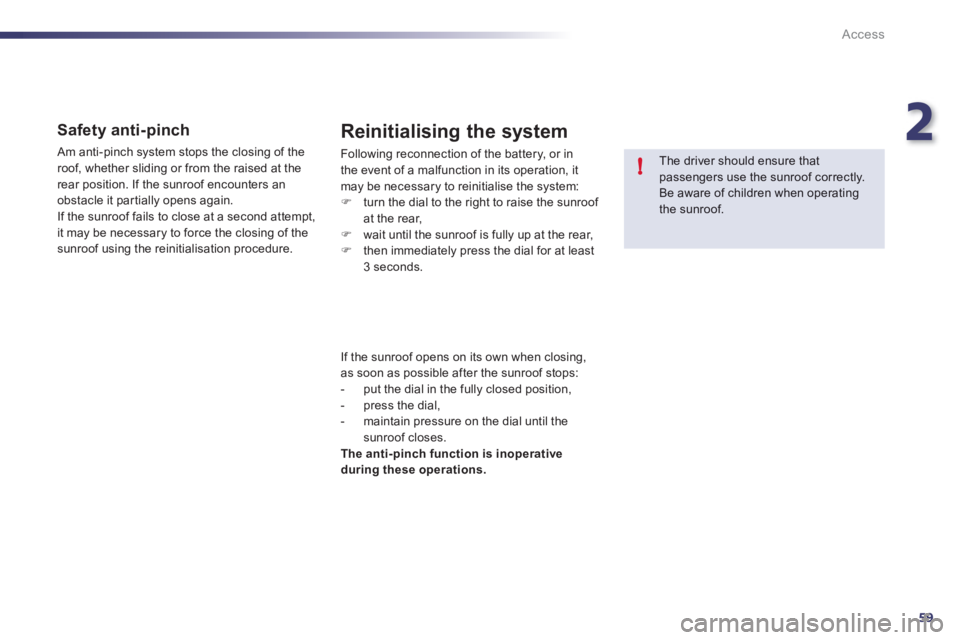
2
59
!
Access
Safety anti-pinch
Am anti-pinch system stops the closing of the
roof, whether slidin
g or from the raised at the
rear position. If the sunroof encounters an
o
bstacle it par tially opens again.
If the sunroof fails to close at a second attempt,
it may be necessary to force the closing of thesunroof using the reinitialisation procedure.
Reinitialising the system
Following reconnection of the battery, or in
the event of a malfunction in its operation, it
may be necessary to reinitialise the system:
�) turn the dial to the right to raise the sunroof
at the rear,
�) wait until the sunroof is fully up at the rear,�)
then immediately press the dial for at least3 seconds.
I
f the sunroof opens on its own when closing,as soon as possible after the sunroof stops:
- put the dial in the fully closed position,
- press the dial,
- maintain pressure on the dial until the
sunroof closes.The anti-pinch function is inoperative during these operations.
The driver should ensure that passengers use the sunroof correctly. Be aware of children when operatingthe sunroof.
Page 62 of 340
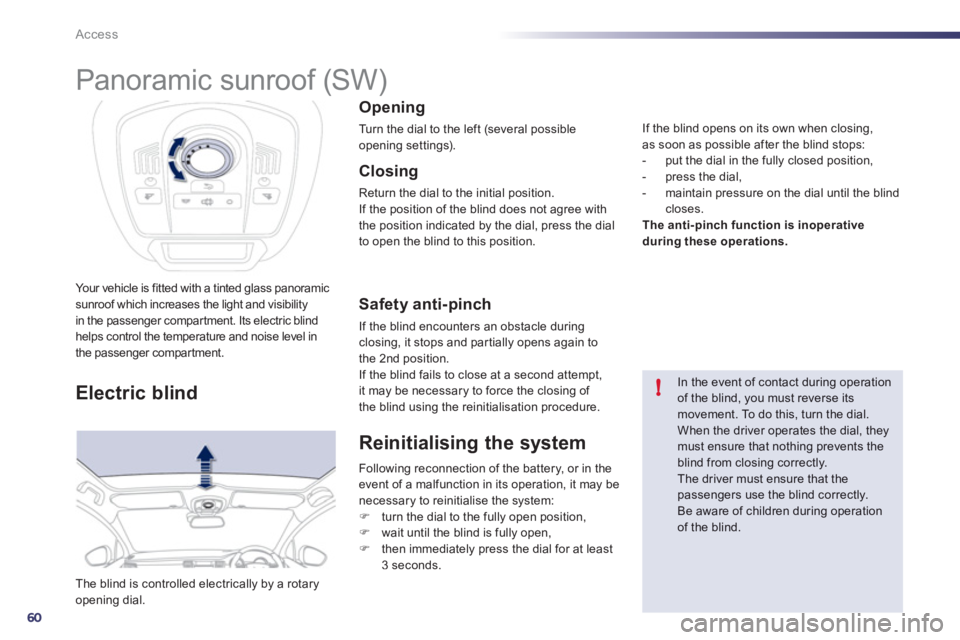
60
!
Access
Your vehicle is fitted with a tinted glass panoramicsunroof which increases the light and visibilityin the passenger compartment. Its electric blind helps control the temperature and noise level in
the passenger compartment.
The blind is controlled electrically by a rotaryopening dial.
Opening
Turn the dial to the left (several possible
opening settings).
Safety anti-pinch
If the blind encounters an obstacle duringclosing, it stops and par tially opens again to
the 2nd position.
If the blind fails to close at a second attempt,
it ma
y be necessary to force the closing of
the blind using the reinitialisation procedure.
Closing
Return the dial to the initial position.
If the position of the blind does not agree with
the position indicated by the dial, press the dial
to open the blind to this position.
Electric blind
In the event of contact during operationof the blind, you must reverse its movement. To do this, turn the dial. When the driver operates the dial, theymust ensure that nothing prevents theblind from closing correctly.
The driver must ensure that the passengers use the blind correctly.
Be aware of children during operationof the blind.
Reinitialising the system
Following reconnection of the battery, or in the event of a malfunction in its operation, it may be
necessary to reinitialise the system: �) turn the dial to the fully open position, �)
wait until the blind is fully open,
�)
then immediately press the dial for at least3 seconds.
I
f the blind opens on its own when closing,
as soon as possible after the blind stops:
- put the dial in the full
y closed position,
- press the dial,
- maintain pressure on the dial until the blind
closes. The anti-pinch function is inoperativeduring these operations.
Panoramic sunroof (SW)